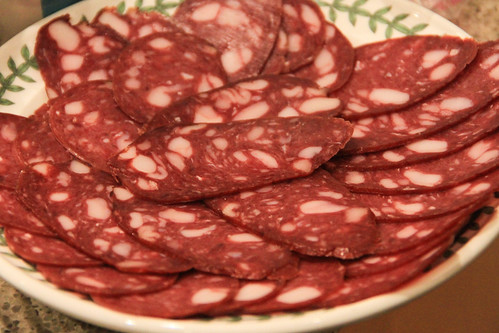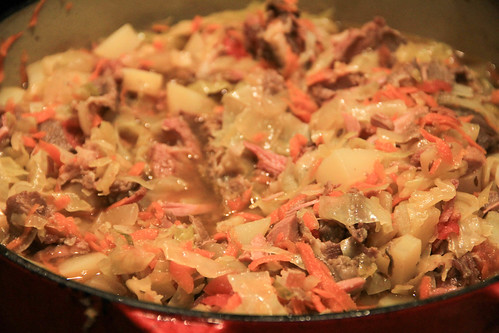This meal was both easy and hard to figure out. Easy, because my close friend Deena co-wrote the best Russian cookbook to come out in English in decades, with Bonnie Frumkin Morales, chef of perhaps the best Russian restaurant in the US, Kachka, so I had an expert and a full book of recipes. But also hard, because I didn’t want to just go the easy way, I wanted to force myself to do some research and learn. Alas, it turns out that Deena and Bonnie really did it right, because frankly what I came up with didn’t differ much from theirs; in fact, all I really had to do was remind Deena that we were keeping it homestyle, and maybe something rustic like kasha would be better than elaborate tsarist confections.
One thing I really did come to learn is the distinction between Russian and Soviet cuisine. Of course there’s a lot of overlap, but just as it did for many other parts of life, the Communist system made a lot of very intentional changes to the way a whole country ate. There was one core cookbook that was the universal reference book, and state cafeterias generally served from the same array of foods, which interestingly did borrow from some of the non-Russian parts of the USSR, particularly the Caucasus. This meal is kind of a combination; the salat Olivier is a pre-Communism dish that evolved through central planning, the kotlety is pure Soviet but has persisted into present day, and shchi has been a soup of the people for about as long as there have been people making soup in that part of the world. Fermented vegetables, too: Deena shared a quote she gathered from a professor once that if you have Eastern European heritage, you would not exist today if it weren’t for sauerkraut, because that was essentially the only way to get Vitamin C during those long winters.

It was a merry crew for this meal: Marisa, Sebastian, Chelsea, Levi, Julie, Marcia, Eileen, Kaz, Susan, Emily, and Sofia. And, of course, Deena, to whom I owe a ton of thanks for all the advice, the trip to the Russian market, and hours of help in the kitchen!
Zakuski | Appetizers


The food at a Russian dinner party starts as soon as you arrive. The table is laden with all sorts of nibbles to get you going. The sprats, mushrooms, and salad below form a part of it, as did sauerkraut and pickled green tomatoes that I made, plus smoked fish and a seriously good kosher salami from the Russian deli.
Nastoyka iz khrena | Horseradish vodka | Recipe
Russians infuse a tremendous variety of things in vodka. Fruits, spices, and herbs are soaked, individually or in combination, for days, weeks, or months, then decanted, shoved in the freezer (or a snowbank), and pulled out whenever a dinner, a visitor, or an illness calls for it. They can be sweet, woodsy, summery, delicate, all sorts of things, but a horseradish vodka is none of these. It’s a punch to your nose, a shock to your mouth, and a bear-hug to your esophagus, all in a matter of seconds, and by the time you’ve recombobulated, you’re ready for some of the strongly flavored nibbles sitting before you.
The Kachka recipe—which is so popular it’s sold by the bottle in Oregon state liquor stores—calls for chunks that are gently infused over the course of a week or two. Since I started in on the preparation fewer than 72 hours before the meal, I used the NY Times’ fast-and-furious method, shaving a stub of horseradish to smithereens with a vegetable peeler and making the whole house smell like Passover. Unlike Kachka’s version, which is famously smooth yet still packs plenty of horseradish perk, the quick extraction afforded by all the surface area, plus some peppercorns, made my version a fair bit harsher, even after I mixed in a bit of honey on Deena’s suggestion. But it’s way better to have hurry-up horseradish vodka than none at all!
Borodinskiy chleb | Dark sourdough rye bread | Recipe
This is the holy grail of sourdough breads to me. It’s got a really complex flavor, a bit sweet from malt and molasses, yet deeply savory from that earthy rye, the tang from long fermentation, and a hint of coriander. Yet it goes with just about everything, from butter and jam to fish and mayonnaise and meaty stews.
The process of making this bread wasn’t the easiest. First, I needed a good malt—that is, sprouted and toasted grains. Rye malt, not surprisingly, is preferred, but nearly impossible to find; but Annie, our friend who runs a bakery, just so happened to have made her own malt (!!) a few days prior and generously lent me some. You really oughtn’t make this without malt, as you need the enzymes to properly develop the sugars that the sourdough feeds on. Speaking of, Annie also gave me a rye sourdough, which saved me the hassle of transitioning over my wheat starter over the course of a few days.
The next tricky part was that it didn’t rise nearly as quickly as the recipe suggested it would, even with some coaxing in the oven with the warming drawer on, so by the time I was supposed to have finished the bake, the loaves still had some time to go in rising. I had to go to a show, so I put them in the basement to slow down the fermentation, then stuck them in the oven when I got home. It finished at around 12:30 AM, but the proof was in the nibbling: this is a damn good recipe.
One hint: go easy on the wheat wash, especially if you plan to keep it on hand for a week or more. Rye bread famously keeps a long time because of the sourdough, but plain flour doesn’t have that benefit, and the top of the bread got moldy while the rest could have lasted a long while. Also, if you’re going through all this effort, at least double the recipe—the ingredient cost is way lower than your time investment!
Marinovannyye griby | Marinated mushrooms | Recipe
Mushrooms, particularly ones foraged in the forest, are a prominent part of home cuisine in Russia. One way to make the most of a good haul is to preserve them, whether by salt curing, or in a liquid marinade as done here. I’d say technique-wise this turned out pretty well, even with boring store-bought brown mushrooms, though I found this particular recipe to be too heavy on the cloves.
Buterbrodiki so shprotami | Sprat canapés | Recipe

Butterbrot is a German word, meaning simply “butter bread,” but in the Russian case the borrowed name seems to refer to something assembled, a sort of sandwich. This version—which, ironically, is built on top of mayo, not butter—is Kachka’s calling card, a nibble so integral to the restaurant that it’s what they offered as a sample recipe for a news article. It reminds me so much of what my grandparents liked to eat: fish, rye (we toasted little slices of the bread I made), boiled egg, and sharp greens. If this sounds good to you, you’ll like it. If it doesn’t, you won’t.
Salat Olivier | Russian salad | Recipe

This salad is so endemic to the cuisine that many places around the world call a mayonnaisey mess of potatoes, meat, and vegetables a “Russian salad” in their language. But, as with so many foods, the origin of this food comes not from a Russian, but rather a French chef who composed something quite a bit fancier involving game birds and shellfish at a posh restaurant in Tsarist times. The recipe got thoroughly Sovietized, with ingredients much more in the commoner’s reach such as boiled eggs and bologna (for a tangent, here’s a fascinating history of how Soviet bologna is derived from the American version!), and it’s now de rigueur at any social event and particularly a New Year’s party.
I though this was not amazing. At first it was quite dull, so lent it a bit more flavor by throwing in a bit of pickle juice, which rescued it somewhat. I’m not sure whether it was my own shortcoming, or if this is just as intended. But the mouthfeel is amazing, and I could definitely see hoovering a ton of this while drunk and hungry.
Pelmeni | Dumplings | Recipe

Apparently, in Siberia, they traditionally make these dumplings by the hundreds and just keep them in outside in the harsh winter, pulling out and boiling from frozen whatever they need for dinner. (In my mind, they throw them straight out the kitchen window into a snowbank, but they’re probably tidier about it than that.) But as so often happens, what’s borne of necessity proves useful even in more resource-filled times: once assembled, these dumplings just don’t keep, you either gotta boil them right away or put in the freezer until cooking, even if that’s just for a half hour.
We would not have eaten this dish if not for Deena. First of all, she co-authored the recipe (which was “adapted” on the linked page). Secondly, she brought the pelmenitsa, the purpose-made honeycomb mold that makes exactly 37 at a time, no fold-and-pinch required. And thirdly, she rolled out the dough, which I just hate doing. So thank you, Deena, for being you, for being a friend, and for having good arm strength and patience to roll dough.

This recipe isn’t strictly traditional; it’s one of the few I’ve found that calls for a smidge of ice water when mixing the meat, but that does wonders for the texture of the filling. You could also put all sorts of other things inside, in fact we made some veggie-friendly ones with mashed potatoes, but apparently when it’s not meat-filled they’re called vareniki. (You know a food is essential to a culture when they come up with totally different names for relatively small variations.)
The most important part of this recipe, though, is the dressing at the end, with butter and that little bit of vinegar. It’s really what makes the whole concoction sing. And disappear. We made about two hundred of these things and they almost all disappeared, despite all the other stuff we served.
Shchi | Cabbage soup | Recipe (which I only kinda followed)

Every recipe I found for this Platonic ideal of a peasant soup quoted the same saying: Shchi da kasha – pishcha nasha, “Shchi and kasha are our food.” (That phrase has fantastic prosody!) Though as the Kachka cookbook explains, there’s not really such a thing as recipe for shchi, but rather you compose it from (usually) cabbage, plus whatever meats and veggies you have on hand. So while this one page I link to calls for chicken, and Kachka suggests spare ribs, I used what I had on hand: part of an unreasonable amount of ham that was gifted to me at a Halloween party, and some thin shaved brisket in the freezer that I’d erroneously purchased for the Korea meal back in February. I’d like to think that the haphazard provenance of the material, more than its identity, made this soup a shchi. Similarly, though more intentionally, I made a quart of sauerkraut using cabbage that I planted in the spring specifically anticipating the Russia meal.
I started this soup at 11 the night before, when I had to throw the bread in the oven. That was long enough to simmer the meats for about an hour and a half; I quickly cooled them in a hotel pan (big surface area = faster cooling), fridged overnight, skimmed fat in the morning, and cooked for another hour until the meat was crumbling. I extracted the meat, cut it finer, and built back up a soup using the sauerkraut plus veggies sauteed on the side. Another simmer, then hotel-pan cooled again and back in the fridge to develop flavor, and finally reheated before dinner.
Especially with a dollop of smetana, this was one frickin’ tasty soup: just enough salt from the ham, a good beefiness from the brisket, and a surprising amount of flavor from the veggies. This particular shchi will never be repeated, yet at the same time it’s recreated a million times a day. That’s the beauty of shchi.
Kurinyye kotlety | Chicken patties | Recipe

The same guy who brought bologna to Russia is also responsible for this dish. Despite the name, it’s not a schnitzel-type pounded meat cutlet, but rather it’s essentially a pan-fried torpedo-shaped meatball. Whatever you call it, it’s an extremely common dish, made of just about any kind of ground meat with grated onions (beware, eyes and knuckles!) and breadcrumbs or milk/water-soaked stale bread. Don’t be fooled by the simple list of ingredients, these are really quite tasty, with the crisp from pan-frying making them a fun texture too. So long as you don’t overcook them, the meat holds plenty of moisture.
Grechnevaya kasha | Buckwheat groats | Recipe

Remember that proverb above? Here’s the second half. While “kasha” in English tends to refer specifically to buckwheat, in Russian it simply refers to any simmered grain, but whatever, here we are with some toasted buckwheat, cooked in water then tossed with a generous amount of butter. I like the nuttiness and toothy texture of buckwheat, so this was a pleasant accompaniment to the kotlety.
Syrniki | Cheese pancakes | Recipe

If you thought pancakes were already a perfect food, did you ever think about taking out most of the wheat and replacing it with cheese? Yup, Russian farmers cheese is dry and soft enough that it mixes up into a really tasty dessert. I also whipped up a basic compote of frozen raspberries with a bit of sugar and lemon, just because. It did take forever to cook small pancakes for 16 people—thank you, Deena, for all that time spent over the stove!—but it did all get eaten, so it was clearly worth it.